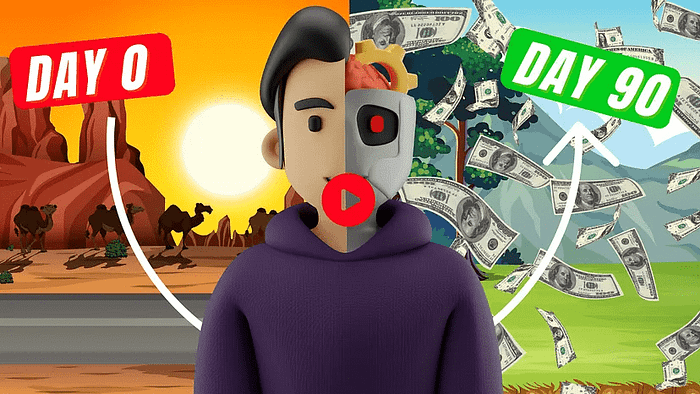Struggling to Generate Leads for Your SaaS Business? Here’s a Guide to 8 Effective Strategies and How to Prioritize Them
In the competitive world of Software-as-a-Service (SaaS) businesses, generating a steady stream of qualified leads is fundamental to achieving sustainable growth. But with so many tactics and channels available, it can be overwhelming to know where to start. This article explores eight powerful lead generation strategies for SaaS companies, along with a three-step framework to help you prioritize and implement them effectively.
We strongly recommend that you check out our guide on how to take advantage of AI in today’s passive income economy.
Table of Contents
Here are the eight key lead generation strategies you can leverage to fuel your SaaS business:
- Social Content Marketing: Social media platforms like LinkedIn, Twitter, and Facebook provide a goldmine for lead generation. By consistently posting educational and informative content that resonates with your ideal customer profile (ICP), you can attract potential customers and establish brand awareness. Craft compelling social media posts that address your target audience’s pain points and offer valuable solutions. Convert these curious scrollers into leads by directing them to your website or landing page with a lead magnet, such as an e-book, white paper, or free trial.
- Social Media Advertising: Amplify the reach of your best-performing social content by transforming it into targeted social media ads. Imagine this: you’ve identified a social media post that consistently generates qualified leads. By allocating a budget to promote this post, you can strategically place it in front of a wider audience who share similar characteristics with those who have already converted. This targeted approach significantly increases the return on investment (ROI) of your social media efforts.
- Search Engine Optimization (SEO): When your ideal customers search for solutions related to your offerings, you want your website to be at the top of the search engine results page (SERP). This is where SEO comes in. By strategically incorporating relevant keywords and phrases throughout your website content, you can improve your organic ranking on search engines like Google. The higher you rank, the more likely potential customers will discover your business and convert into leads.
- Search Engine Marketing (SEM): While SEO is a long-term strategy that can take months to yield significant results, SEM allows you to pay your way to the top of the SERPs. With SEM, you create targeted pay-per-click (PPC) campaigns using platforms like Google Ads. When potential customers search for specific keywords, your ad appears at the top of the results page, driving them directly to your website or landing page.
Inbound vs. Outbound Lead Generation
The four strategies mentioned above are all considered inbound lead generation techniques. This means you’re creating high-quality content and using various online channels to attract potential customers to you. Inbound leads are generally considered more qualified because they’ve already demonstrated some interest in the solutions you offer.
There’s another side to the lead generation coin, however: outbound lead generation. Here, you take a more proactive approach by directly reaching out to potential customers who may not be aware of your brand. Let’s explore some outbound lead generation strategies:
- Outbound Sales: Cold calling and emailing can still be effective lead generation methods, especially for businesses with high-value products or services. The key is personalization. Avoid sending generic emails or making robotic sales calls. Instead, invest time in researching your target audience and craft targeted messages that resonate with their specific needs and challenges.
- Direct Mail: While it might seem like a relic of the past, direct mail can be a surprisingly powerful tool for lead generation, particularly for businesses targeting high-value customers. A well-crafted direct mail campaign, like a personalized FedEx envelope containing a brochure or special offer, can grab attention and generate a high open rate compared to traditional emails.
- Partnerships: Partnering with complementary businesses in your industry can be a strategic way to expand your reach and tap into a new audience. Identify potential partners who share a similar customer base and collaborate on co-marketing initiatives, such as co-hosted webinars, guest blog posts, or joint content creation. This allows you to leverage your partner’s audience while offering value to theirs.
- Customer Referrals: One of the most effective lead generation strategies often overlooked is leveraging the power of customer referrals. Your existing happy customers are a goldmine for qualified leads. Implement a referral program that incentivizes them to recommend your product or service to their network. Testimonials and case studies featuring satisfied customers can also be powerful tools to convince potential customers to convert.
Prioritizing Your Lead Generation Efforts: A Three-Step Framework
Now that you’ve explored eight lead generation strategies, it’s crucial to understand how to prioritize them effectively. Here’s a three-step framework to guide you:
- Identify Your Ideal Customer Profile (ICP): The foundation of any successful lead generation strategy is a deep understanding of your ideal customer. Develop a detailed ICP that outlines their demographics, psychographics, pain points, and motivations. The more specific you are about your target audience, the better you can tailor your messaging and choose the most effective lead generation channels. This detailed profile will guide your lead generation efforts, ensuring you target the right people with the right message.
- Craft a Compelling Message: Once you know who you’re targeting, it’s time to craft a message that resonates with them. Your messaging should clearly articulate the value proposition of your product or service and address the specific needs and challenges of your target audience. Develop a strong strategic narrative that differentiates you from competitors and captures the attention of potential customers. This strategic narrative will be the backbone of all your marketing and sales efforts.
- Implement a Consistent Action Plan (The “Broadway Show”): Instead of trying to implement all eight lead generation strategies at once, focus on two or three key channels that align best with your ICP and messaging. Develop a consistent action plan, or what we’ll call the “Broadway Show,” that outlines the specific activities you’ll perform each week to generate leads. This plan should include clear metrics to track your progress and identify areas for improvement.
Diving Deeper into Lead Generation Tactics
Let’s explore each of these lead generation tactics in more detail, providing practical tips and examples for implementation:
1. Social Content Marketing: Building a Community and Generating Leads
Social media is a powerful tool for building brand awareness, engaging with potential customers, and generating leads. To be successful with social content marketing, it’s essential to:
- Identify the Right Platforms: Determine where your ideal customers spend their time online. Are they more active on LinkedIn, Twitter, Facebook, or other platforms? Focus your efforts on the platforms where you’re most likely to reach your target audience.
- Create Valuable Content: Share content that educates, entertains, or inspires your target audience. This could include blog posts, articles, infographics, videos, or social media updates.
- Use Strong Calls to Action: Encourage engagement and lead capture by including clear calls to action in your social media posts. For example, you could ask people to visit your website, download a lead magnet, or sign up for a webinar.
2. Social Media Advertising: Amplifying Your Reach
Social media advertising allows you to target specific demographics, interests, and behaviors, making it a highly effective way to reach a wider audience. To maximize the effectiveness of your social media ads:
- Target Your Audience: Use the targeting options available on social media platforms to reach your ideal customer profile.
- Create Compelling Ad Copy and Visuals: Your ads should be visually appealing and include clear, concise messaging that resonates with your target audience.
- Track Your Results: Monitor the performance of your ads and make adjustments as needed to optimize your campaigns.
3. Search Engine Optimization (SEO): Driving Organic Traffic
SEO is a long-term strategy that involves optimizing your website and content to rank higher in search engine results. Key SEO tactics include:
- Keyword Research: Identify the keywords and phrases that your ideal customers use when searching for solutions related to your offerings.
- On-Page Optimization: Optimize your website content, including title tags, meta descriptions, and header tags, with relevant keywords.
- Off-Page Optimization: Build high-quality backlinks to your website from other reputable websites.
4. Search Engine Marketing (SEM): Instant Visibility
SEM provides immediate visibility in search engine results through paid advertising. To run effective SEM campaigns:
- Keyword Targeting: Select relevant keywords to target your ads.
- Ad Copywriting: Write compelling ad copy that encourages clicks.
- Landing Page Optimization: Create dedicated landing pages that are optimized for conversions.
5. Outbound Sales: Personalized Outreach
Outbound sales can be effective for generating leads, particularly for high-value products or services. Key considerations for outbound sales include:
- Targeted Account Lists: Focus your efforts on a specific set of accounts that are most likely to benefit from your offerings.
- Personalized Messaging: Craft personalized emails and phone calls that address the specific needs and challenges of each prospect.
- Value-Driven Approach: Focus on providing value to prospects rather than simply pitching your product or service.
6. Direct Mail: Making a Tangible Impression
Direct mail can be a powerful way to stand out from the digital noise. To create effective direct mail campaigns:
- Personalization: Personalize your mail pieces to increase engagement.
- High-Quality Materials: Use high-quality paper and printing to create a professional impression.
- Clear Call to Action: Include a clear call to action that tells recipients what you want them to do.
7. Partnerships: Expanding Your Reach
Strategic partnerships can be a valuable source of leads. To build successful partnerships:
- Identify Complementary Businesses: Look for businesses that share a similar customer base but offer non-competing products or services.
- Develop Co-Marketing Initiatives: Collaborate on joint marketing activities, such as webinars, content creation, or events.
- Establish Clear Agreements: Outline the terms of the partnership in a formal agreement.
8. Customer Referrals: Leveraging Word-of-Mouth Marketing
Customer referrals are a highly effective way to generate qualified leads. To encourage referrals:
- Implement a Referral Program: Offer incentives to customers who refer new business.
- Make it Easy to Refer: Provide customers with tools and resources to make it easy for them to refer your business.
- Ask for Testimonials and Case Studies: Use customer testimonials and case studies to showcase the value of your product or service.
The Importance of a Strategic Narrative for Lead Generation
A compelling strategic narrative is crucial for all lead generation activities. It provides a consistent message across all channels and helps you differentiate yourself from competitors. Your strategic narrative should answer the following questions:
- Who is your target audience?
- What problem do you solve for them?
- What is your unique value proposition?
- Why should they choose you over your competitors?
Putting It All Together: The Broadway Show
The “Broadway Show” is a consistent set of sales and marketing activities that you perform each week to generate leads. It involves:
- Choosing the Right Channels: Focus on two or three key channels that align best with your ICP and messaging.
- Consistent Execution: Perform your chosen activities consistently each week.
- Data Analysis and Iteration: Track your results and make adjustments as needed to optimize your campaigns.
By following this comprehensive guide, you can develop a robust lead generation strategy that drives growth for your SaaS business. Remember, consistent effort, strategic planning, and a deep understanding of your ideal customer are the keys to long-term lead generation success. Lead generation is an ongoing process, requiring constant refinement and adaptation to the ever-changing market landscape. Implementing these strategies effectively will create a powerful lead generation engine for your SaaS business. Lead generation is the lifeblood of any SaaS company, and these tactics will help you thrive.

We strongly recommend that you check out our guide on how to take advantage of AI in today’s passive income economy.




